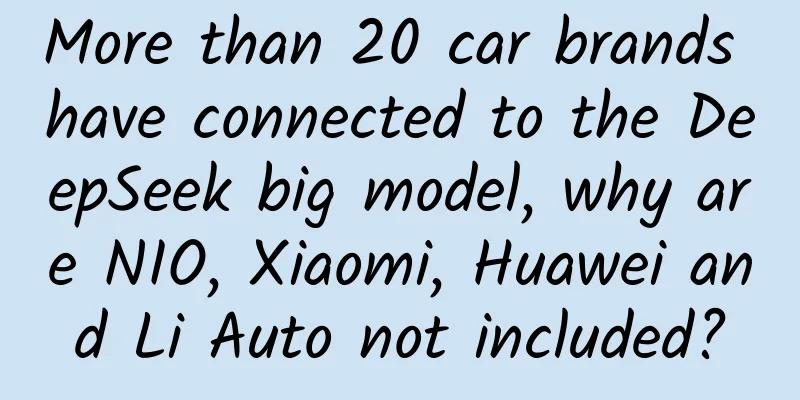More than 20 car brands have connected to the DeepSeek big model, why are NIO, Xiaomi, Huawei and Li Auto not included?

|
Facing DeepSeek, the reactions of major Chinese automakers varied. Some jumped on board immediately, while others watched calmly from the sidelines. As of now, more than 20 automobile companies including BYD, Geely, Dongfeng, Great Wall, Zeekr, and Zhiji have announced the completion of in-depth integration with DeepSeek. Car machine service providers such as Zebra Intelligent Driving and Ecarx, which belong to the same automotive industry supply chain, have also joined the ecosystem. Judging from the response efficiency of car brands, today's car companies have developed a high sensitivity to new technologies. Of course, there are exceptions. In the overwhelming news about big companies embracing DeepSeek, we did not find any signs of Wei, Xiaoli, Huawei, and Xiaomi. Of course, there is no news about Tesla. Now is the time to fully embrace artificial intelligence. Why are Nio, Xiaomi, Li Auto, Huami and others so calm? Are they too confident in their own intelligence, or are they considering something else? Perhaps, in the eyes of these car manufacturers, there is no strong correlation between attaching importance to intelligence and whether to integrate DeepSeek. DeepSeek is indeed powerful, but neither car manufacturers nor users care too much about whether their cars can write a high-level paper. In other words, how to help users get a more intelligent driving experience is what users really care about and what car companies are more concerned about. It is undeniable that the emergence of DeepSeek has indeed shown us the great development prospects of large models in vehicles. However, connecting DeepSeek to the car computer and improving the user experience is not just a matter of connecting it. It also needs to be able to call the car-side information as inference corpus to provide car owners with more personalized services. How much computing resources these inferences require, what kind of hardware support is needed, and whether Internet services are needed are all issues that car manufacturers must consider. In addition, the integration with DeepSeek involves a lot of supply chains. At least, at present, chip, cloud service and terminal hardware manufacturers (mobile phones + smart cars) all need to be connected. For example, cloud service providers need to deploy DeepSeek on the cloud if they don’t want to see the message “Server busy, please try again later” during car-machine interaction. In addition, users need to access this open source model in order to use DeepSeek successfully in the car. In other words, terminal manufacturers and users need to complete the deployment of DeepSeek on the terminal side of their products. How difficult is this? Let me first state the conclusion. The cost of deploying a full-featured version of DeepSeek on your vehicle is likely to be several times the cost of your vehicle itself. Using the 671B R1 version (671 billion parameters) for calculation, it requires nearly 1,300G of video memory, far exceeding the end-side computing resources of PCs, mobile phones, and cars. If we have to settle for the next best thing and use a 7B or 10B distillation model, its reasoning ability is significantly different from the full-blooded version. If you just connect the DeepSeek model to the car computer, it is actually just a "name". It is equivalent to adding a voice entry. It is probably more convenient for users to use this DeepSeek on the car computer than on a mobile phone or computer. Therefore, those car companies that have not immediately integrated DeepSeek may not have ignored the intelligence of cars, but rather they are looking at new technologies calmly and cautiously before making more comprehensive deployments. This is actually a responsible approach to users. Judging from the feedback from major car companies, DeepSeek's main role in cars is still as a voice assistant. Looking at those car companies that have not yet joined DeepSeek, they have actually done a good job in this regard. For example, Ideal's MindGPT, Weilai's NomiGPT, Xiaomi's "Xiao Ai" and Huawei's "Xiao Yi", DeepSeek's current capabilities in cars have not surpassed them. In fact, when many car companies are trying to integrate with DeepSeek, the experiences of failure and success will help later car companies to explore a smoother path. In an era where technology determines the future, it is important to pay attention to the direction of new technologies. However, as long as the technology is not outdated, it is not a bad thing to be more calm about new technologies and add less cognitive burden to users. For car companies, it doesn’t matter whether they are the first wave to “try new things”. Tencent has always been a latecomer in new technologies, and it is still far ahead in the industry. Focusing on laying a solid foundation for the subsequent "entry" and joining in force is the key to winning the future intelligent war. Just like Wei, Xiaopeng, Li Auto, Huami and Xiaomi, none of them were the first to enter the automotive industry, but they joined at the right time and had enough strength. Now, haven't they caught up or even led? No one can predict who will dominate the automotive industry in the future, but as of now, DeepSeek is not really a key factor in determining the automotive market. |
Recommend
Four principles for effective questioning
I have mentioned in many articles: This is an era...
SparkToro: Survey shows that nearly 30% of users use ChatGPT to assist in programming
What tasks do people mainly use ChatGPT to solve?...
Is this the real "water ball" in the universe? With more than 10% of water, it can "kill" the earth in seconds!
Author: Huang Xianghong Duan Yuechu In the depths...
Is the “four-hour sleep method” reliable? Experts remind →
Recently, Zhang Chaoyang, founder of Sohu, talked...
Please save these tips for achieving mobile app user growth!
When traffic and users in various industries are ...
How to enable showcase permissions on Douyin? What are the qualifications for opening a window display on Douyin?
What are the requirements for opening a product s...
Yi Zhongtian's Chinese History: An Lushan Rebellion
After the Anshi Rebellion, people could only dream...
14 frequently asked questions about childhood influenza, answered by experts from Beijing Children's Hospital!
Respiratory diseases are common in children in wi...
Wearing black underwear makes you more likely to get cancer? The truth behind "Don't buy black underwear" is revealed
Black is one of the most common colors in textile...
iOS 9 exposed a major bug: bypassing the lock screen password to access the photo album and contacts
Data shows that the installation rate of iOS 9 re...
How to keep deep space communication connected? The probe has a "good voice" and the ground has a pair of "good ears"
There is a lot of high-energy radiation in space,...
GSMA: 5G's contribution to the global economy could reach $2.2 trillion by 2034
GSMA predicts that 5G will contribute $2.2 trilli...
Which day is better for sleeping? The national autumn cool sleeping map will help you unlock the best sleeping "position"
Do you remember how hard it was to fall asleep ev...
Daniel Wu: How to allocate the budget for information flow advertising? Nick Cheung: Just do it without any limit!
Please don’t think that Ai Qijun is a clickbait t...
The Top 1 Chinese University is controversial, but the Top 1 Chinese University Food must be this!
The Top 1 Chinese University is controversial, bu...









